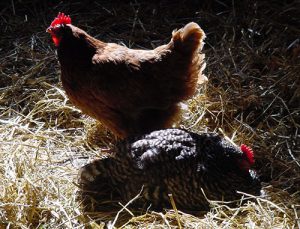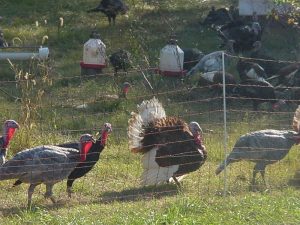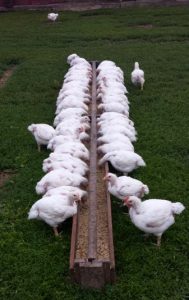Bulletin #2220, Best Management Practices for Small Scale Poultry Producers in Maine
Developed by Dr. Richard Brzozowski, Extension Professor, University of Maine Cooperative Extension, Donna Coffin, Extension Professor, University of Maine Cooperative Extension, and Dr. Michael Darre, Extension Poultry Specialist, University of Connecticut, along with agricultural service providers at the 2015 Applied Poultry Science Professional Development Project ENE14-131 funded by SARE and held in Freeport, Maine.
For information about UMaine Extension programs and resources, visit extension.umaine.edu.
Find more of our publications and books at extension.umaine.edu/publications/.
Poultry keepers care about the welfare of their birds and understand that poor husbandry practices will result in higher mortality, fewer eggs, and slower growth. These best management practices are intended to encourage small-scale poultry producers to adopt the highest standards of poultry care and handling under a variety of management systems.
University specialists, Extension educators, and agriculture service providers from New England and New York developed this list of Best Management Practices to assist small-scale poultry growers to provide the best of care for their birds, minimize losses due to disease and predation, as well as minimizing the impact on the environment while assuring a high quality, wholesome product for their family and customers.
The list is designed for small-scale poultry producers. Small-scale poultry is defined as any enterprise that involves 25 to 5,000 birds.
Poultry Best Management Practices by Category
Feed and Water
Water
- Provide fresh, potable water to all birds at all times. Allow adequate space for birds to access water. Use a nipple system for water, if possible, to avoid manure-tainted water, waste, and wet bedding.
- Avoid open water sources.
Feed
- Select appropriate feed for birds based on species, age, and stage of production.
- Purchase feeds from a reputable dealer.
- Use only high-quality feeds. Mark and rotate feedstocks, using oldest feeds first. Use feed before it gets old; strive to use feeds before 30-60 days depending on the season. Feeds can be stored for longer periods in the winter months.
- Store feeds in rodent-proof containers, out of direct sunlight. For bagged feeds, use a metal garbage can lined with a plastic bag — covered, insulated, protected against heat and cold, as well as moisture- and rodent-proof. For bulk feed, use metal, fiberglass or wooden bins. When using bins, make sure grain is cleared from sides on a weekly basis.
- Clean your feeders regularly.
- Avoid feeding long-stem hay or grass (over 4 – 6 inches) to poultry, to minimize crop impaction.
- Watch for any illness or death loss due to over-feeding. This will vary by breed and goal weight.
- Keep a small sample from each feed batch in a ziplock bag. Label it and put it in the freezer for future testing if you suspect a health problem stemming from the feed. Can be discarded after six months.
- Be sure to feed pastured birds adequately. Don’t rely on pasture to supply 100% of nutrition requirements.
Health and Biosecurity
Health
- Thoroughly clean, disinfect, and sanitize facilities on a regular basis.
- When buying poultry from a hatchery, have chicks vaccinated with Marek’s Disease and coccidiosis vaccines. If a coccidiosis vaccine is used, do not use feed medicated with a coccidiostat.
- Remove birds that are ill, nonproductive or exhibiting signs of cannibalism. Be aware that some birds can be non-symptomatic. These birds can still cause problems for the rest of the flock. Even though quarantine is not 100% foolproof, it is a very effective practice to minimize health problems in the flock. Be aware of poultry diseases that are common to your region and applicable to your species of birds.
- Be familiar with and use state animal diagnostic lab or veterinarian if have a serious problem.
- Follow an Integrated Pest Management (IPM) program. Be aware of external parasites and predators common to poultry in your state and area. Be familiar with and follow state regulations on livestock carcass disposal. Consider composting for bird mortalities; be aware of neighbors who have poultry and prevent their contact with your birds.
- Provide a dust bath for birds.
- Be observant of all birds on a daily basis. Watch their movement and behavior. Inspect droppings. Inspect eggs. Pick up your birds frequently to gauge their weight and feel their keel bone. Monitor birds’ gaits especially if raising fast-growing meat birds. Record findings.
- Read and follow any medication label before using.
- Judicious use of any medications and follow appropriate proper withdrawal.
- Treat pullets for any disease before they begin to lay eggs.
- Know the humane methods of euthanizing an animal (gas; inhalation; injectable agent; cervical dislocation; decapitation).
Biosecurity
- Buy chicks from a National Poultry Improvement Program (NPIP) certified source.
- Have a written biosecurity plan for your poultry operation that addresses visitors, then follow it.
- Prevent wild birds and other domesticated birds from mixing with your birds. Use netting and a solid roof over runs or coops to prevent aerial entries.
- Keep poultry species separate.
- When introducing new birds to a flock, quarantine these birds for 14-21 days to monitor their health and if necessary, treat them for suspect conditions.
- Do fecal tests for intestinal parasites when birds are in quarantine to help make treatment decisions.
- House and feed show birds separately from production birds.
Facilities and Environment
 Provide appropriate housing as it relates to your management system (year-round or seasonal). Housing should protect birds from the elements (rain, snow, wind, cold temperatures, hot temperatures) as well as from predators.
Provide appropriate housing as it relates to your management system (year-round or seasonal). Housing should protect birds from the elements (rain, snow, wind, cold temperatures, hot temperatures) as well as from predators.- Housing should provide a dry and draft-free environment. Provide a good exchange of air through a natural or mechanical ventilation system, to prevent a build-up of ammonia. Be aware of shared air for disease prevention and control.
- Housing structure should be constructed of materials that can be easily cleaned and disinfected (metals and plastics are generally better than wood for cleaning and disinfecting). Eliminate all sharp surfaces to prevent injury. Eliminate corners, in brooders, to prevent suffocation or piling of chicks.
- Keep heat lamps away from any combustible materials. Hang lamps with an adjustable chain or wire at an appropriate height. Use lamps with porcelain sockets.
- For indoor birds, provide adequate floor space (as it relates to their species, size, age, and stage of production), allowing for: ease of movement; feeding and watering space; roosting space; escape space from those higher on the pecking order, and nesting space for egg laying birds.
- Provide shavings or other litter material as bedding for clean and dry conditions. Manage bedding so it is deep, clean, and dry (wet shavings can harbor parasite eggs). Use a non-slip surface for bedding (no newspaper or straw). Baby chicks should have at least 4-6″ of bedding material.
- Provide adequate roosting space for your birds at a variety of heights. Lowest roost should be 1′ above ground. Use round wood stock as roost material rather than a round pipe, with a diameter appropriate for the species. Avoid metal pipe due to coldness and slipperiness. Painted wood is easier to clean and disinfect. Design roosting areas for ease of cleaning underneath (roost removal or hinged sets that are lifted out of the way).
- For layers, provide one nest box for every 4-5 birds. Stack nests no more than 3 nest boxes in height to prevent birds from hurting themselves in jumping/falling. Consider ease of cleaning when designing a nest box system. Nest boxes should be bedded with clean pine shavings. Avoid hay and straw as nest box bedding. Replace or replenish nesting material on a regular basis for clean eggs. Consider a roll-out design of nest boxes, eliminating the need for shavings.
- If you are going to free-range hens, test soil for lead and remove old paint chips or old equipment out of the yard.
Bird Management
- In brooding young birds, observe birds in order to adjust heat source as required; chicks generally start at 95°F and drop 5°F per week until at about 70-75°F.
- Have a “disposal option” for unwanted/cull/roosters before taking ownership of birds.
Meat birds
- Plan for processing before ordering chicks (especially if for commercial sale).
- Select suitable growing stock for market conditions (i.e., slower growing broilers for larger carcass weight).
- Provide at least 4 hours of darkness each day for good health.
Egg Layers
- Provide an adequate amount of lighting for your type of bird. Egg-type pullets (not yet laying) should be on less than 12 hours of light during growth and switch to 16 hours per day at first egg. Red light is better than white for heat lamps; birds can see well in red light.
- Train birds to nests before they begin to lay.
- Run a fecal test for parasites and deworm birds before they come into lay.
- Molting (feather loss and non-productivity) is natural and be aware of the timing of molting.
- Feather pecking occurs when birds are growing new feathers and when they are bored.
Record Keeping
- Keep health and medical records, including any bird mortalities, disease outbreaks, type, treatment dates, symptoms, vaccination records, what meds used, a log of visitors to the farm, etc. Budget for health care and necropsies
- Keep financial records, including any and all purchases such as birds, feed, supplements, equipment, electricity, bedding, medications, tools, labor, disinfectants, etc. For quick economic calculations use a break-even calculator.
- Keep production records, including the average rate of lay (if necessary, counting eggs/day and charting it over the year), dressed weight of all broilers, and feed conversions.
- Record number and breeds of birds started, type of feed, growth (body weight) over a set time, egg production, feed consumption, water use, etc.
- Keep sales records to support the farm business plan, such as income from each enterprise.
Food Safety
For any egg or meat processing facility, follow FSIS (Food Safety Inspection Service) sanitation procedures.
Egg processing
- Collect eggs daily.
- Clean eggs with constantly flowing wash water 20°F warmer than eggs.
- Stack eggs no more than five cartons deep.
- Don’t sell dirty or cracked eggs.
- Eggs should be stored below 45°F. Eggs should be candled and sized (depends on size of operation and to whom you’re selling).
- Use new egg cartons for packing eggs; check with your state regarding appropriate carton labeling for eggs.
Meat processing
- Withdraw feed 12 hours prior to processing meat birds. Keep fresh water available.
- Transport birds in clean well-ventilated crates.
- Do a good antemortem inspection to cull any sick birds prior to slaughter.
- Make sure that meat processors/handlers are not sick.
- Use potable water for all processing.
- If intestines are punctured during processing, do an extra rinse of carcass and sanitize work surface.
- Processed meat birds need to be chilled to 40°F as soon as possible (within 4 hours).
Regulations
- Refer to your state’s regulations if you are slaughtering your own birds.
- Understand the requirements of organic and conventional production and processing.
- Understand the FDA egg safety rules.
- Obtain general AND product liability insurance if you are selling food products. Many insurance companies will not insure egg producers or poultry processors. Consult with an insurance company that works with agricultural producers.
- Keep current with local, state, and federal regulations. To understand the full scope of regulations, investigate their source by going straight to the code (not word of mouth from farmer or inspector).
- Know local zoning and retail food permit regulations.
This project supported in part by the Northeast Sustainable Agriculture Research and Education (SARE) program. SARE is a program of the National Institute of Food and Agriculture, U.S. Department of Agriculture.
Information in this publication is provided purely for educational purposes. No responsibility is assumed for any problems associated with the use of products or services mentioned. No endorsement of products or companies is intended, nor is criticism of unnamed products or companies implied.
© 2015
Call 800.287.0274 (in Maine), or 207.581.3188, for information on publications and program offerings from University of Maine Cooperative Extension, or visit extension.umaine.edu.
In complying with the letter and spirit of applicable laws and pursuing its own goals of diversity, the University of Maine System does not discriminate on the grounds of race, color, religion, sex, sexual orientation, transgender status, gender, gender identity or expression, ethnicity, national origin, citizenship status, familial status, ancestry, age, disability physical or mental, genetic information, or veterans or military status in employment, education, and all other programs and activities. The University provides reasonable accommodations to qualified individuals with disabilities upon request. The following person has been designated to handle inquiries regarding non-discrimination policies: Director of Equal Opportunity and Title IX Services, 5713 Chadbourne Hall, Room 412, University of Maine, Orono, ME 04469-5713, 207.581.1226, TTY 711 (Maine Relay System).



